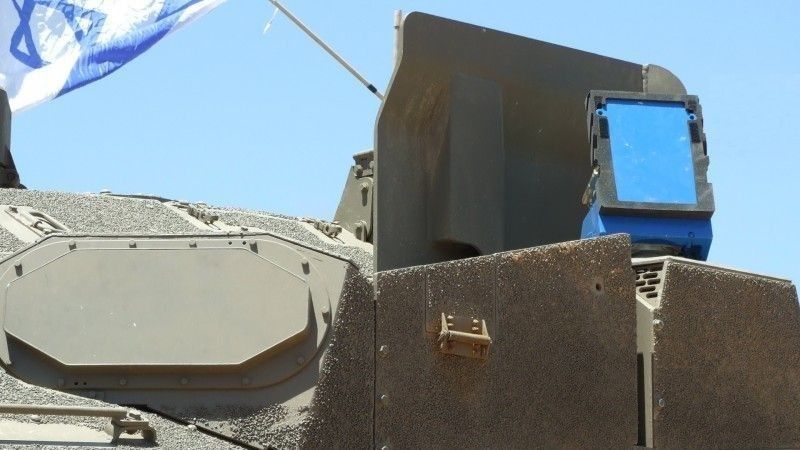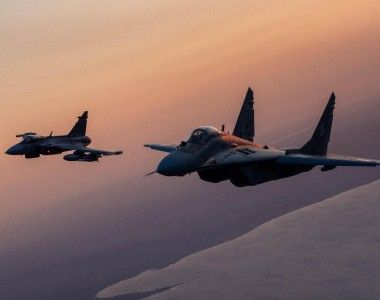Active Protection Systems for the Fighting Vehicles of the Polish Armed Forces

Over the last couple of decades, the necessity to equip armoured fighting vehicles with new protection measures has become obvious, to complement a myriad of armour types. Hard-kill active protection systems allow for a great increase in fighting vehicles« survivability and crew protection levels. Considering the battlefield experience gathered in Ukraine for instance, the procurement of systems as such for the Polish military has now become one of the burning priorities. Let us have a closer look at a couple of designs that could be potentially acquired.
Over the last couple of decades, the necessity to equip armoured fighting vehicles with new protection measures has become obvious, to complement a myriad of armour types. Hard-kill active protection systems allow for a great increase in fighting vehicles' survivability and crew protection levels. Considering the battlefield experience gathered in Ukraine for instance, the procurement of systems as such for the Polish military has now become one of the burning priorities. Let us have a closer look at a couple of designs that could be potentially acquired.
Active Protection Systems in the Polish Armed Forces
The Polish Armed Forces are planning to procure a variety of active protection systems for the military vehicles, as Defence24.pl was told by the spokesperson for the Armament Agency, Lt. Col. Krzysztof Płatek. “The matters tied to the final definition of the target configuration of the M1 Abrams, and K2 Black Panther main battle tanks, also in the area of hard-kill active protection systems that would be operated by the Polish Armed Forces are handled by the Minister of Defence’s plenipotentiary for the armour programs, namely the Land Forces’ Inspector of the General Command of the Armed Forces.”
The efforts made by the Polish Ministry of Defence, and the Polish Armed Forces, aimed at the procurement of APS solutions shall be portrayed in a positive light. Let us remember, that a system as such comes at just a fraction of the price of a complete fighting vehicle, such as a main battle tank, significantly increasing the vehicle's survivability on the battlefield saturated with ATGMs.
Equipping the latest Polish MBTs (M1A1FEP, M1A2SEPv3, K2) with systems as such hence becomes critical. Furthermore, APS solutions have now also become relevant for IFVs - and these usually have armour that is weaker than one applied in the case of the main battle tanks. Therefore, vehicles as such are far more vulnerable when facing enemy anti-tank assets, including anti-tank grenade launchers. Thus, the release issued by the Armament Agency, regarding the Borsuk IFV, shall also be perceived as a good sign: "The Borsuk IFV can accommodate an active protection system, within the scope of upgrade headroom taken into the account when considering the vehicle's payload weight. A system as such can be acquired and implemented, once a relevant decision within that scope is made by an expert institution."
Let us have a closer look at the active protection systems that could be potentially considered as solutions boosting the survivability of armoured fighting vehicles, operated by the Polish Armed Forces.
Trophy
The Trophy active protection system has been designed and is being manufactured by Rafael; it was first commissioned in 2009 and implemented on the Merkava Mk 4M main battle tanks. The first combat experience regarding this system has been gathered in 2011. From that moment on, not a single vehicle using the Trophy APS was destroyed by the enemy. One should remember that before that system was fielded, portable anti-tank weapons had only 40% of lethality.
Given how effective the Trophy system was - diminishing the level of threat posed by man-portable anti-tank weapons to zero, starting in 2016 the IDF command decided to integrate the Trophy HV system on all Merkava Mk 4 main battle tanks, and on the heavy Namer IFVs and their derivatives. Let us note that the Namer IFV is derived directly from the Merkava design.
Trophy HV includes four Elta EL/M-2133 F-band/G-band radars. Their detection capabilities may be complemented by passive optoelectronic sensors, reducing the EM signature. Most of the time, the radars may remain on standby, while the early detection of missile launches is handled by the passive EO sensors.
After the threat is detected, the radars are activated. These, precisely define the launch location and trajectory and determine whether the missile should be considered to be a threat to the carrier vehicle. Should the emergence of the threat be confirmed, the computer compares the radar signature of the emerging threat to the available signature database and then computes the intercept location, also launching the effector - the MEFP (Multiple Explosively Formed Penetrators) warheads.
The MEFP warhead meanwhile generates a cloud of multiple, explosively formed penetrators that can penetrate the shell of the incoming threat, destroying the shaped charge warhead by detonating or damaging it, rendering it incapable of correct operation. The neutralized threat falls to the ground before reaching the vehicle or hits the armour without generating any damage.
The Trophy APS solution can intercept all types of anti-tank grenades, ATGMs, recoilless gun projectiles, and shaped-charge or HE projectiles fired from MBT guns or with the use of similar weapons. However, the system in question is unable to effectively intercept kinetic penetrators (APDS, APFSDS), or explosively formed penetrators carried by artillery submunitions.
The standard configuration of the Trophy system includes two modules. Each of them uses two radar antenna arrays and a rotating base for the interceptor, as well as a magazine for the extra interceptor, and an auto-reloading system. Each of the magazines houses three or four spare interceptor charges, and one extra charge that remains ready for use, on the rotating base. In total, the system carries 8-10 countermeasures at once. Further Trophy effectors can be carried internally, or externally.
The family of Trophy systems includes the following systems:
- Trophy HV (Heavy Vehicles), designed for heavy, tracked armoured platforms;
- Trophy MV (Medium Vehicles), designed for medium-sized armoured platforms, with tracked or wheeled drivetrains;
- Trophy LV, for light, wheeled vehicles.
- Trophy VPS (Vehicle Protection System), derived from Trophy MV, is the latest iteration of the system. It is much more compact, and much lighter. Thus, it is viewed as a universal solution that can be installed on both heavy, and medium platforms as well. Furthermore, Trophy VPS has been selected as the new protection measure for the Challenger 3 MBT. The AbramsX demonstrator vehicle also features that solution.
The Trophy HV, meanwhile, has been certified for integration on the following MBTs: Merkava Mk3D, Merkava Mk4M, M1A2SEPv2, M1A2SEPv3, Leopard 2A7A1, as well as on the heavy Namer IFVs.
The Trophy MV system has been tested on the M2A3 IFV, LAV III and Stryker APCs. A developmental variant of the Trophy VPS system is also considered as a possible option for the Challenger 3 main battle tank.
The Trophy HV system has already been certified for use on the M1A2SEPv3 MBT - it is viewed as a possible solution for the Polish Abrams tanks. More importantly, the system discussed here has been tested in combat. It is a mature solution. Furthermore, Trophy HV and Trophy MV systems are currently being integrated on the K2 main battle tanks.
It is worth considering whether the implementation of the Trophy VPS would be more prospective. It is a lighter, more modern solution. The above means that all main battle tanks, infantry fighting vehicles, or even armoured personnel carriers could use the same active protection system.
Korean Active Protection System
KAPS (Korean Active Protection System) is another possible option that may be considered. It pursues a design philosophy different from that adopted in the case of the Trophy solution. The KAPS system uses two rotating countermeasure launchers, and the effectors come in a form of 70 mm HE grenades. Each of the launchers has two grenades as such ready. The solution as such has one, decisive advantage that needs to be mentioned here. The launcher can rapidly intercept two incoming projectiles in a short time.
The disadvantage this system has is the lack of an automatic reloading system for the launcher. In other words, one or two crew members need to exit the vehicle, reach for spare effectors, and manually reload the launchers.
The system features two radar antenna arrays, two IR sensors, and a central control unit. The solution has been successfully tested, but it has not yet been implemented, for several reasons. First, due to the cost. Secondly, some issues emerged when the KAPS solution was coupled with the soft-kill MSSG (Multispectral Screening Smoke Granade) system.
Most probably, the radar sensors of both systems jam each other, which could potentially render the KAPS system ineffective. Thus, it is required to use one system at a time only.
KAPS is also being offered for the Polish K2PL main battle tanks. One should take into account the fact, that this system is yet to prove its worth, it is not a mature solution. It also is burdened with some limitations typical for solutions as such, shared with the Iron Fist system for instance. On the other hand, APS systems lighter from Trophy HV are available - not becoming a major burden for the vehicle, eliminating the necessity to redesign the carrier platform before the system is implemented. Furthermore, these systems are relatively compact. There is no necessity to remove them for railway/road transport operations.
Alternatives
Alternative solutions can also be considered by the potential buyer. The best path here would be to domestically develop its own APS. An effort as such, named ZASOP (Integrated Active Protection System for Vehicles) has already been undertaken. At least one technology demonstrator has been made. During the test programme, it was capable of effectively intercepting RPGs.
Unfortunately, for reasons that remain unclear, the work on the system has been abandoned.
Rheinmetall Strike Shield system is another possible alternative here. It is a scattered-architecture solution in which the vehicle shell features sensor, and effector modules, arranged separately.
Thanks to a solution as such, the system can intercept simultaneous projectiles coming from multiple directions. On the other hand, once used, the modules need to be replaced. In that sense, the system is similar to ERA. However, the threat is neutralized before actually hitting the armour.
Iron Fist is another alternative solution. It is becoming much more mature, and it has successfully passed test programmes pursued by the IDF, and the US Army - both users hope to operate this solution soon. In the Israeli case, the Iron Fist would be used on the Eitan APCs. The US Army would integrate this system on the M2A4 IFVs.
Similar to the KAPS system discussed above, the Iron Fist launcher houses two countermeasures. These require manual reloading, involving spare charges kept in the vehicle, or externally.
Summary
Regardless of the final selection that would be made, undoubtedly the Polish Armed Forces need to implement APSs for the armoured fighting platforms, especially the ones used by the frontline units - main battle tanks, and infantry fighting vehicles.
Unfortunately, when it comes to allied, or neutral nations, there is a narrow selection of systems as such available. Only one of those systems has been fully matured and combat-proven. The active protection systems shall not be viewed solely as a defensive measure, as they could also be perceived as an offensive asset, promoting manoeuvrability and diminishing the risk of the emergence of a scenario in which the given vehicle is effectively eliminated, especially with the use of ATGMs.
Meanwhile, resigning from the implementation of the APS solution could be a painful mistake. Russia serves as a prime example here. The USSR has been a pioneer in developing APS solutions such as Dozhd, Shtandard, or Shatior which evolved into Zaslon, Afganit, and Arena.
The Arena system (Arena-M) has been successfully tested and integrated into the T-72B3 Model 2016. Most probably, however, Russia did not manage to finalize the test programme before the invasion that happened on 24th February 2022. The cost of the system is another factor that probably prevents any immediate procurement from happening.
Nevertheless, the lack of APS on the Russian main battle tanks has been an advantage for the Armed Forces of Ukraine. This is a valuable lesson that Poland needs to learn. Facing our potential adversary, we would not have a quantitative advantage. Poland can, and even needs to achieve a qualitative advantage. Active protection systems for armoured vehicles are one of the ways to do that.



